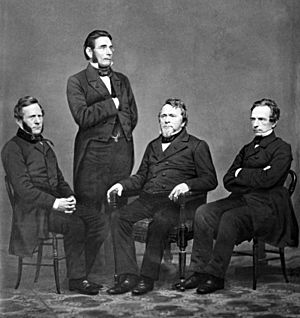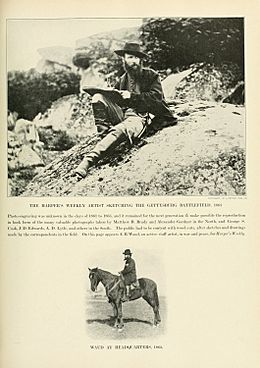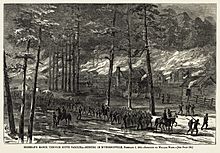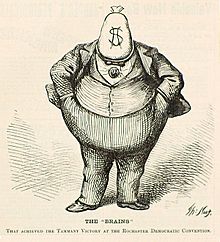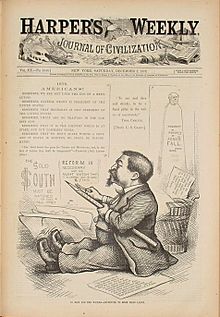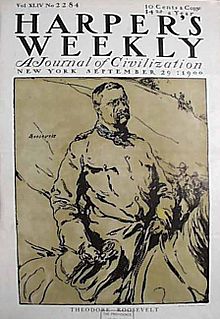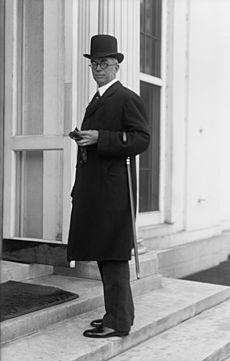Harper's Weekly facts for kids
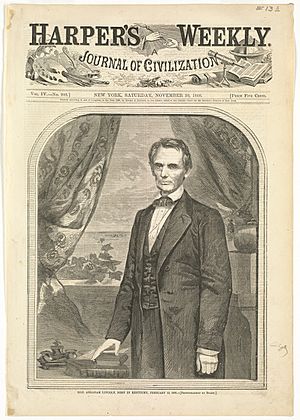
Harper's Weekly cover featuring President-Elect Abraham Lincoln; illustration by Winslow Homer from a photograph by Mathew Brady (November 10, 1860)
|
|
| Illustrators |
|
|---|---|
| Categories | News, politics |
| Frequency | Weekly |
| Founder | Fletcher Harper |
| Founded | 1857 |
| First issue | January 3, 1857 |
| Final issue | May 13, 1916 |
| Company | Harper & Brothers |
| Country | United States |
| Based in | New York City, New York |
| Language | English |
Harper's Weekly, A Journal of Civilization was an important American magazine. It was published in New York City by Harper & Brothers from 1857 to 1916. The magazine shared news from America and other countries. It also included stories, essays, and funny parts, all with many pictures.
Harper's Weekly was famous for its detailed coverage of the American Civil War. It showed many illustrations of events from the war. During its most important time, the magazine was home to the famous political cartoonist Thomas Nast.
Contents
History of Harper's Weekly
How the Magazine Started
Fletcher Harper and his brothers James, John, and Wesley started their publishing company, Harper & Brothers, in 1825. They saw how popular The Illustrated London News was. So, in 1850, Fletcher Harper began publishing Harper's Magazine.
This monthly magazine featured well-known writers like Charles Dickens. After a few years, the magazine was so popular that people wanted a weekly version. In 1857, Harper & Brothers started Harper's Weekly in New York City. By 1860, about 200,000 copies were sold each week.
Pictures were a very important part of Harper's Weekly. The magazine became known for using some of the best illustrators of the time. These included Winslow Homer, Granville Perkins, and Livingston Hopkins.
Thomas Nast's Cartoons
One of the most famous people who worked for Harper's Weekly was Thomas Nast. He was a political cartoonist. Nast joined the magazine in 1862 and worked there for over 20 years. He was known for his powerful drawings that made fun of politicians. Many people call him the father of American political cartooning.
Nast was the first to use an elephant as the symbol for the Republican Party. He also drew the popular image of Santa Claus. His drawings helped make Santa Claus a well-known part of Christmas traditions in the late 1800s.
Reporting on the Civil War
Harper's Weekly was the most popular magazine in the United States during the American Civil War. Before the war, the magazine tried to stay neutral on the issue of slavery. This was to avoid upsetting its many readers in the Southern states. Some people who wanted to end slavery even called it "Harper's Weakly."
The magazine had supported Stephen A. Douglas for president instead of Abraham Lincoln. But when the Civil War began, Harper's Weekly fully supported President Lincoln and the Union (the North). In July 1863, an article about an escaped slave named Gordon included a photograph of his back, which was badly scarred from whippings. This picture showed many readers in the North how cruel slavery was. It also encouraged many free Black people in the North to join the army.
Some of the most important articles and pictures of that time were Harper's reports on the war. Besides drawings by Homer and Nast, the magazine also published illustrations by Theodore R. Davis and the brothers Alfred and William Waud.
In 1863, George William Curtis became the magazine's political editor. He was one of the people who helped start the Republican Party. He stayed in this role until he died in 1892. His articles supported ideas like making government jobs based on skill, not favors.
Helping Elect Presidents
After the Civil War, Harper's Weekly openly supported the Republican Party. It helped elect Ulysses S. Grant as president in 1868 and 1872. In the 1870s, cartoonist Thomas Nast started a strong campaign against William "Boss" Tweed. Tweed was a powerful and corrupt political leader in New York. Nast even turned down a large bribe to stop his attacks. Tweed was arrested in 1873.
Nast and Harper's also played a big part in helping Rutherford B. Hayes win the presidential election in 1876. Hayes later said that Nast was "the most powerful, single-handed aid [he] had." After this election, Nast's role at the magazine became less important.
In 1884, George W. Curtis and Thomas Nast both agreed they could not support the Republican candidate, James G. Blaine. They felt he was linked to corruption. Instead, they supported the Democratic candidate, Grover Cleveland. Nast's cartoons helped Cleveland become the first Democrat elected president since 1856. Nast's grandson said that Nast's support likely helped Cleveland win by a small amount.
Nast's last drawing for Harper's Weekly was a Christmas illustration in December 1886. Some people said that when Nast left, Harper's Weekly lost its political importance. However, the magazine remained influential.
The Early 1900s
After 1900, Harper's Weekly focused more on political and social issues. It featured articles by important political figures of the time, like Theodore Roosevelt. The editor of Harper's, George Harvey, was an early supporter of Woodrow Wilson for president. Harvey even made sure that each issue of Harper's Weekly had the words "For President—Woodrow Wilson" on it.
Harper's Weekly published its last issue on May 13, 1916. It then joined with another magazine called The Independent. The Independent later merged with The Outlook in 1928.
The 1970s Revival
In the mid-1970s, Harper's Magazine used the Harper's Weekly name for a new magazine. This new Harper's Weekly was published every two weeks. Much of its content came from contributions sent in by its readers.
See also
 In Spanish: Harper's Weekly para niños
In Spanish: Harper's Weekly para niños


